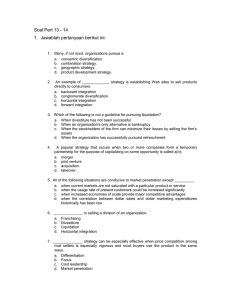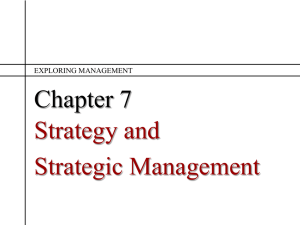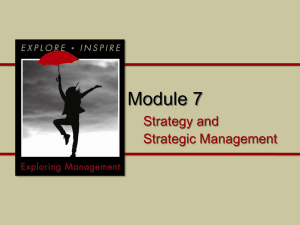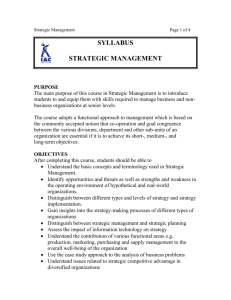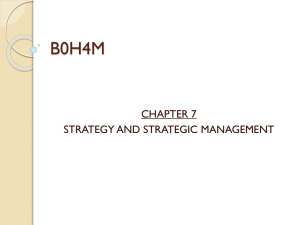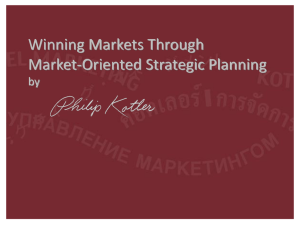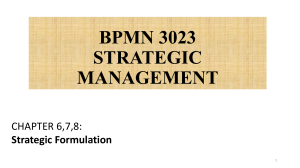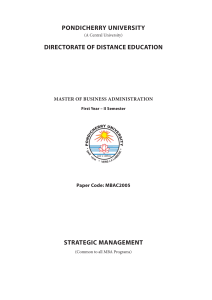STRATEGIC MANAGEMENT Chapter 9 1
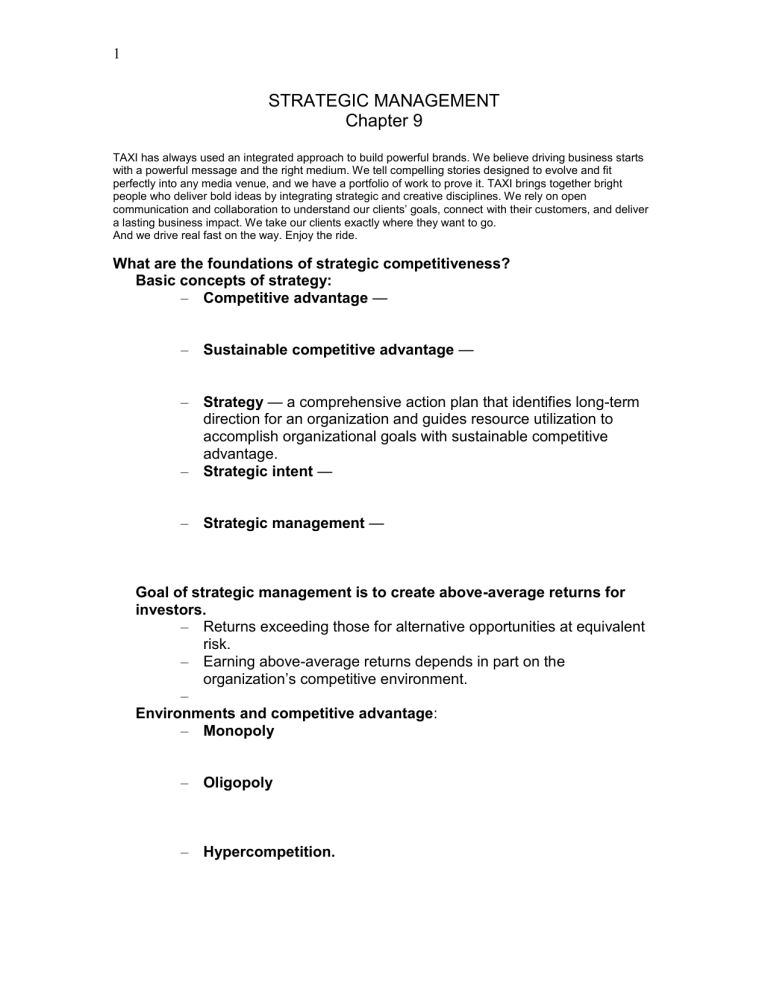
1
STRATEGIC MANAGEMENT
Chapter 9
TAXI has always used an integrated approach to build powerful brands. We believe driving business starts with a powerful message and the right medium. We tell compelling stories designed to evolve and fit perfectly into any media venue, and we have a portfolio of work to prove it. TAXI brings together bright people who deliver bold ideas by integrating strategic and creative disciplines. We rely on open communication and collaboration to understand our clients’ goals, connect with their customers, and deliver a lasting business impact. We take our clients exactly where they want to go.
And we drive real fast on the way. Enjoy the ride.
What are the foundations of strategic competitiveness?
Basic concepts of strategy:
– Competitive advantage
—
– Sustainable competitive advantage
—
– Strategy — a comprehensive action plan that identifies long-term direction for an organization and guides resource utilization to accomplish organizational goals with sustainable competitive advantage.
– Strategic intent
—
– Strategic management
—
Goal of strategic management is to create above-average returns for investors.
– Returns exceeding those for alternative opportunities at equivalent risk.
– Earning above-average returns depends in part on the
– organization’s competitive environment.
Environments and competitive advantage :
– Monopoly
– Oligopoly
– Hypercompetition.
2
Strategy formulation
– The process of creating strategy.
– Involves assessing existing strategies, organization, and environment to develop new strategies and strategic plans capable of delivering future competitive advantage.
What is the strategic management process?
Strategic question for strategy formulation:
Strategy implementation
–
The process of allocating resources and putting strategies into action.
– All organizational and management systems must be mobilized to support and reinforce the accomplishment of strategies.
Essential tasks for strategy implementation:
– Identify organizational mission and objectives.
– Assess current performance vis-à-vis mission and objectives.
– Create strategic plans to accomplish purpose and objectives.
– Implement the strategic plans
–
Evaluate results; change strategic plans and/or implementation processes as necessary.
Analysis of mission:
– The reason for an organization’s existence.
– Good mission statements identify:
• Customers
• Products and/or services
• Location
• Underlying philosophy
–
An important test of the mission is how well it serves the organization’s stakeholders
Analysis of values:
– Values are broad beliefs about what is or is not appropriate.
– Strong core values for an organization helps build institutional identity, gives character to an organization, and it backs up the mission statement.
– Organizational culture reflects the dominant value system of the organization as a whole.
3
Organizational culture
– Shapes the values of managers and other organization members.
–
Points people in common directions.
– Helps build institutional identity.
– Gives character to the organization in the eyes of employees and external stakeholders.
– Backs up the mission statement. Guides the behavior of organizational members in meaningful and consistent ways.
Analysis of objectives:
What are our Strengths?
What are our Weaknesses?
Analysis of organizational resources and capabilities:
– Important goal of assessing core competencies.
–
Potential core competencies:
• Special knowledge or expertise.
• Superior technology.
• Efficient manufacturing approaches.
• Unique product distribution systems.
4
What are our Opportunities?
What are our Threats?
Analysis of industry and environment:
– Assessment of macro environment:
•
Technology.
• Government.
• Social structures and population demographics.
•
Global economy.
• Natural environment.
– Analysis of industry environment:
• Resource suppliers.
• Competitors.
• Customers.
What types of strategies are used by organizations?
Strategic forces to be examined in conducting an industry analysis:
– Industry competitors
– New entrants
– Suppliers
– Buyers
– Substitutes
Strategic implications of strategic forces:
– Unattractive industry.
•
Five forces are favorable for the firm.
– Attractive industry.
• Five forces are unfavorable for the firm.
Porter’s Five Strategic Forces
5
Questions addressed by different strategic level:
Growth and diversification strategies:
– Growth strategies
• Seek an increase in size and the expansion of current operations.
– Types of growth strategies:
• Concentration strategies
•
Diversification strategies
– Related diversification
– Unrelated diversification
–
Vertical integration
Restructuring and divestiture strategies:
Divestiture
– sells off parts of the organization to focus attention and resources on core business areas.
– Readjusting operations when an organization is in trouble.
– Retrenchment
•
Correcting weaknesses by making changes to current operations.
• Liquidation
• Restructuring
– Downsizing and rightsizing
• Restructuring through divestiture
Global strategies:
– Globalization strategy.
– Multidomestic strategy.
– Transnational strategy
6
Cooperative strategies
– Strategic alliances — two or more organizations partner to pursue an area of mutual interest.
– Types of strategic alliances:
• Outsourcing alliances –
• Supplier alliances –
• Distribution alliances –
• E-business strategies
– The strategic use of the Internet to gain competitive advantage.
– Popular e-business strategies
• Business-to-business (B2B) strategies – uses IT and Web portals to link organizations vertically in supply chains.
•
Business-to-customer (B2C) strategies
–uses IT and
Web portals to link businesses with customers.
Web-based business models:
Brokerage model –
Advertising model –
Merchant model
–
Subscription model -
Infomediary model – collecting information on users and selling it to other businesses.
Community model-
7
How are strategies formulated?
Opportunities for achieving sustainable competitive advantage:
– Cost and quality
– Knowledge and speed
– Barriers to entry
– Financial resources
Porter’s generic strategies for gaining competitive advantage:
Differentiation strategy – where the organization’s resources and attention are directed toward making its products appear different from those of the competition. (Coke, Pepsi)
Cost leadership strategy –where the organization’s resources and attention are directed toward minimizing costs to operate more efficiently than the competition. (President’s Choice Cola)
Focused differentiation strategy – where the organization concentrates on one special market segment and tries to offer customers in that segment a unique product (A&W Root Beer, Canada
Dry)
Focused cost leadership strategy - – where the organization concentrates on one special market segment and tries that segment to be the provider with lowest costs. (Red Cherry Pop)
Portfolio planning approach
–
Designed to help managers decide on investing scarce organizational resources among competing business opportunities.
– Useful for multibusiness or multiproduct situations.
BCG matrix
– Ties strategy formulation to analysis of business opportunities according to …
• Industry or market growth rate
– Low versus high
• Market share
–
Low versus high
BCG matrix — business conditions and related strategies:
– Stars
– Cash cows
– Question marks
8
– Dogs
• Low share/low growth businesses.
• Preferred strategy — retrenchment by divestiture.
Types of adaptive strategies:
– Prospector strategy
• Pursuing innovation and new opportunities in the face of risk and with prospects for growth.
– Defender strategy
• Protecting current market share by emphasizing existing products and current share without seeking growth.
– Analyzer strategy
• Maintaining stability of a core business while exploring selective opportunities for innovation and change.
–
Reactor strategy
• Merely responding to competitive pressure in order to survive.
Strategic planning failures that hinder strategy implementation:
– Failures of substance
• Inadequate attention to major strategic planning elements
– Failures of process
• Poor handling of strategy implementation
– Lack of participation error
–
Goal displacement error
Strategic leadership
– The capability to inspire people to successfully engage in a process of continuous change, performance enhancement, and implementation of organizational strategies.
Critical tasks of strategic leadership …
